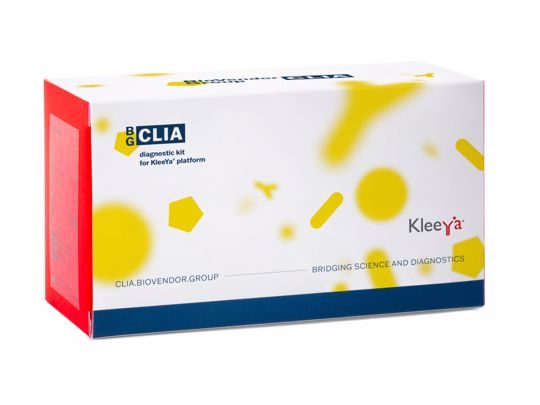CLIA Chromogranin A
The Chromogranin A CLIA test kit is a chemiluminescent assay for detection and quantitation of chromogranin A in human serum or plasma.
The Chromogranin A CLIA test kit is a chemiluminescent assay for detection and quantitation of chromogranin A in human serum or plasma.
| Catalog Number: | CL-CGA100 |
|---|---|
| Size: | 100 tests |
| Regulatory status: | CE IVD |
| Clinical topic: | Oncology |

The prevalence of neuroendocrine tumors (NETs) in Europe is approximately 3 cases per 100,000 inhabitants and has been steadily increasing in recent years. NETs are a rare but clinically significant group of tumors arising from the uncontrolled proliferation of neuroendocrine cells. They most commonly occur in the gastrointestinal tract, lungs, pancreas, and kidneys. These tumors are classified into functional types, which produce excess biologically active hormones causing specific symptoms, and non-functional types, which do secrete hormones, but in amounts insufficient to cause clinical manifestations.
Chromogranin A (CgA) is a key biomarker for the diagnosis and monitoring of NETs, enabling earlier detection due to its elevated levels in most NET subtypes.
CgA:
Compared to other biomarkers used in NET diagnostics, CgA is measured in serum or plasma and represents a more reliable and practical method than the measurement of 5-hydroxyindoleacetic acid (5-HIAA) in urine. 5-HIAA, a serotonin metabolite, shows elevated levels primarily in gastrointestinal carcinoid tumors. However, its concentrations may be influenced by dietary factors, such as the consumption of serotonin-rich foods (e.g., bananas, tomatoes, pineapples), which can reduce test reliability.
Neuron-specific enolase (NSE), on the other hand, is not elevated in all NET types. Its levels typically rise in aggressive, poorly differentiated forms, such as small cell lung carcinoma, and its specificity for NETs is limited.
Thanks to its broad applicability, high sensitivity, and simple, non-invasive detection, Chromogranin A is considered a valuable tool not only for the early diagnosis of neuroendocrine tumors but also for their long-term monitoring and assessment of treatment efficacy.
| Assay time | 20 min |
| Assay stability | 30 days on board stability / In use stability until the expiration date at storage temperature 2-8 °C |
| Sample matrix | Serum, Plasma |
| Sample volume | 10 µL |
| Measuring range | 0 - 2000 ng/ml |
| Assay/kit content | Reagent Cartridge with specific reagents for the assay, magnetic beads, calibrators |
| Complementary products | Anchor® Tips, Stackable Cuvette, KleeYa Trigger Pack, KleeYa Wash buffer |
| Note | The kits are CE-IVD certified and intended for professional use. |